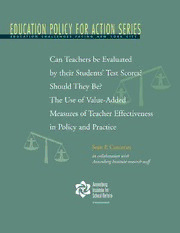
ERIC ED522163: Can Teachers Be Evaluated by Their Students' Test Scores? Should They Be? The Use of Value-Added Measures of Teacher Effectiveness in Policy and Practice. Education Policy for Action Series PDF
Preview ERIC ED522163: Can Teachers Be Evaluated by Their Students' Test Scores? Should They Be? The Use of Value-Added Measures of Teacher Effectiveness in Policy and Practice. Education Policy for Action Series
EDUCAT IO N POLI CY FOR A CTION SERIES E D U C A T I O N C H A L L E N G E S F A C I N G N E W Y O R K C I T Y Can Teachers be Evaluated by their Students’ Test Scores? Should They Be? The Use of Value-Added Measures of Teacher Effectiveness in Policy and Practice Sean P. Corcoran in collaboration with Annenberg Institute research staff EDUCAT IO N POLICY FOR ACTI ON S ER IES E D U C A T I O N C H A L L E N G E S F A C I N G N E W Y O R K C I T Y Can Teachers be Evaluated by their Students’ Test Scores? Should They Be? The Use of Value-Added Measures of Teacher Effectiveness in Policy and Practice Sean P. Corcoran in collaboration with Annenberg Institute research staff About the Annenberg Institute for School Reform TheAnnenbergInstituteforSchoolReformisanational policy-researchandreform-supportorganization,affiliated withBrownUniversity,thatfocusesonimprovingcondi- tionsandoutcomesforallstudentsinurbanpublic schools,especiallythoseservingdisadvantagedchildren. TheInstitute’svisionisthetransformationoftraditional schoolsystemsinto“smarteducationsystems”thatdevelop andintegratehigh-qualitylearningopportunitiesinall areasofstudents’lives–atschool,athome,andinthe community. TheInstituteconductsresearch;workswithavarietyof partnerscommittedtoeducationalimprovementtobuild capacityinschooldistrictsandcommunities;andshares itsworkthroughprintandWebpublications.Ratherthan providingaspecificreformdesignormodeltobeimple- mented,theInstitute’sapproachistoofferanarrayof toolsandstrategiestohelpdistrictsandcommunities strengthentheirlocalcapacitytoprovideandsustain high-qualityeducationforallstudents. AgoaloftheInstituteistostimulatedebateinthefieldon mattersofimportantconsequencefornationaleducation policy.Thisreportprovidesonesuchperspectivebutit doesnotnecessarilyreflecttheopinionoftheAnnenberg InstituteforSchoolReform. AnnenbergInstituteforSchoolReformatBrownUniversity Box1985 Providence,RhodeIsland02912 233Broadway,Suite720 NewYork,NewYork10279 www.annenberginstitute.org ©2010BrownUniversity CONTENTS Figures iv About the Author v About the Series vi Acknowledgments vi Introduction ............................................................................................................................1 1 Value-Added Measurement: Motivation and Context ................................................1 2 What Is a Teacher’s Value-Added? ..................................................................................4 3 Value-Added in Practice: New York City and Houston ..............................................6 The New York City Teacher Data Initiative 6 The Houston ASPIRE Program 12 4 Challenges to the Practical Implementation of Value-Added .................................14 What is being measured? 14 Is the measurement tool appropriate? 16 Can a teacher’s unique effect be isolated? 18 Who counts? 19 Are value-added scores precise enough to be useful? 21 Is value-added stable from year to year? 26 5 Discussion ............................................................................................................................28 References ...........................................................................................................................29 Appendix A: Race to the Top Definitions of Teacher Effectiveness and Student Achievement ......................................................................34 Appendix B: Sample New York City Teacher Data Report, 2010 ........................35 Appendix C: Sample New York City Teacher Data Report, 2009 .......................36 FIGURES Figure 1 Factorsaffectingaverageachievementintwoclassrooms:hypotheticaldecomposition ...............4 Figure 2 Factorsaffectingyear-to-yeartestscoregainsintwoclassrooms: hypotheticaldecomposition ......................................................................................................................5 Figure 3 NewYorkCityTeacherDataInitiativetimeline ...................................................................................6 Figure 4 NewYorkCityvalue-addedmodel:predictors ...................................................................................10 Figure 5 Teachervalue-addedontworeadingtests:Houstonfourth-andfifth-gradeteachers ...............17 Figure 6 Percentofstudentswithatestscoreandpercentcontributingtovalue-addedestimates, gradesfourtosix,Houston,1998–2006 .............................................................................................20 Figure 7 Averageconfidenceintervalwidth,NewYorkCityTeacherDataReports,2008-2009 ............23 Figure 8 Percentofoverlappingconfidenceintervals,ELAandmath ...........................................................24 Figure 9 Year-to-yearstabilityinvalue-addedrankings:HISDreadingtest,2000–2006 ..........................26 Figure 10 Year-to-yearstabilityinELAandmathvalue-addedrankings:NewYorkCityTeacherData Reports,2007-2008 ..................................................................................................................................27 iv CanTeachersbeEvaluatedbytheirStudents’TestScores?ShouldTheyBe? About the Author Hisrecentpublicationscanbefoundinthe JournalofPolicyAnalysisandManagement,the Sean P. Corcoranisanassistantprofessorof JournalofUrbanEconomics,EducationFinance educationaleconomicsatNewYorkUniver- andPolicy,andtheAmericanEconomicReview. sity’sSteinhardtSchoolofCulture,Education, andHumanDevelopment,anaffiliatedfaculty oftheRobertF.WagnerGraduateSchoolof PublicService,andaresearchfellowatthe InstituteforEducationandSocialPolicy (IESP).Hehasbeenaresearchassociateofthe EconomicPolicyInstituteinWashington, D.C.,since2004andwasselectedasaresident visitingscholarattheRussellSageFoundation in2005-2006.Inadditiontobeingamember oftheboardofdirectorsoftheAssociationfor EducationFinanceandPolicy(formerlythe AmericanEducationFinanceAssociation),he servesontheeditorialboardofthejournal EducationFinanceandPolicy. Corcoran’sresearchfocusesonthreeareas: humancapitalintheteachingprofession,edu- cationfinance,andschoolchoice.Hisrecent papershaveexaminedlong-runtrendsinthe qualityofteachers,theimpactofincome inequalityandcourt-orderedschoolfinance reformonthelevelandequityofeducation fundingintheUnitedStates,andthepolitical economyofschoolchoicereforms.In2009, heledthefirstevaluationoftheAspiringPrin- cipalsPrograminNewYorkCity,andheis currentlyworkingonaretrospectiveassessment oftheBloomberg-Kleinreformstoschool choiceandcompetitioninNewYorkCityfor theAmericanInstitutesforResearch.Heco- editsabookseriesonalternativeteachercom- pensationsystemsfortheEconomicPolicy Institute,andinrecentyearshehasbeeninter- estedinvalue-addedmeasuresofevaluating teachereffectiveness,boththeirstatistical propertiesandtheirobstaclestopractical implementation. AnnenbergInstituteforSchoolReform v About the Series Acknowledgments Education Policy for Action: Education IthanktheAnnenbergInstituteforSchool Challenges Facing New York Cityisaseries Reformfortheinvitationtoconductthis ofresearchandpolicyanalysesbyscholarsin researchandwritethisreport.DeinyaPhenix fieldssuchaseducation,economics,public wasanimmensehelpfromstarttofinish. policy,andchildwelfareincollaborationwith NormFruchter,IvonneGarcia,MeganHester, stafffromtheAnnenbergInstituteforSchool ChristinaMokhtar,andEricZacharyoffered Reformandmembersofabroadlydefined thoughtfulandconstructivefeedbackatmulti- educationcommunity.Papersinthisseries plepointsduringtheprocessofwritingand aretheproductofresearchbasedontheInsti- preparingformyJanuary27,2010,presenta- tute’slargelibraryoflocalandnationalpublic tion,whichwaspartoftheEducationPolicy educationdatabases;workwiththeInstitute’s forActionconversationseries.Manyaudience dataanalysisteam;andquestionsraisedand membersatthiseventofferedinsightful conclusionsdrawnduringapublicpresenta- thoughtsandcomments,andIwouldparticu- tionandconversationwithuniversityand larlyliketoexpressmyappreciationtoLeo publicschoolstudents,teachers,foundation CaseyfromtheUnitedFederationofTeachers representatives,policyadvocates,education forservingasadiscussant. reporters,newsanalysts,parents,youth,and IwouldalsoliketothankJenniferJennings communityleaders. andAndrewBeveridgeforsharingdatafrom Amongtheissuesthattheseriesaddressesare theHoustonIndependentSchoolDistrict, severalpressingtopicsthathaveemergedfrom RhondaRosenbergandJackieBennettofthe theInstitute’sresearchandorganizingefforts. UnitedFederationofTeachersforproviding Someofthetopicscoveredintheseriesare: assistancewiththeNewYorkCityTeacher •Confrontingtheimpendinggraduationcrisis DataReportdata,andRachelColeforher •ThesmallschoolsexperimentinNewYork researchassistance.AmyMcIntoshandJoanna City CannonoftheNewYorkCityDepartmentof Educationwereinstrumentalinproviding •Positivebehaviorandstudentsocialand backgroundontheTeacherDataInitiativeand emotionalsupport assistedmeincorrectingfactualerrors.All •Modesofnewteacherandprincipalinduc- remainingerrorsaremyown. tionandevaluation ManythankstotheRobertSterlingClark Foundationforitssupportofthepubliccon- versationsfromwhichthisreportandtheother publicationsintheseriesgrew. Foradownloadableversionofthisreportand moreinformationabouttheseries,pleasevisit <www.annenberginstitute.org/WeDo/NYC_ Conversations.php>. vi CanTeachersbeEvaluatedbytheirStudents’TestScores?ShouldTheyBe? 1 Introduction Value-Added Measurement: Motivation and Context Value-addedmeasuresofteachereffectiveness arethecenterpieceofanationalmovementto Traditionalmeasuresofteacherqualityhave evaluate,promote,compensate,anddismiss alwaysbeencloselylinkedwiththosefoundin teachersbasedinpartontheirstudents’test teacherpayschedules:yearsofexperience,pro- results.Federal,state,andlocalpolicy-makers fessionalcertification,anddegreeattainment. haveadoptedthesemethodsenmasseinrecent Asrecentlyasthe2001NoChildLeftBehind yearsinanattempttoobjectivelyquantify Act(NCLB),teacherqualitywascommonly teachingeffectivenessandpromoteandretain formalizedasasetofminimumqualifications. teacherswithademonstratedrecordofsuccess. UnderNCLB,“highlyqualified”teachersof Attentiontothequalityoftheteachingforce coresubjectsweredefinedasthosewithatleast makesagreatdealofsense.Nootherschool abachelor’sdegree,astatelicense,anddemon- resourceissodirectlyandintenselyfocusedon stratedcompetencyinthesubjectmatter studentlearning,andresearchhasfoundthat taught(e.g.,througharelevantcollegemajor teacherscananddovarywidelyintheireffec- ormaster’sdegree). tiveness(e.g.,Rivkin,Hanushek&Kain2005; However,theseminimumqualificationshave Nye,Konstantopoulos&Hedges2004;Kane, notbeenfoundbyresearcherstobestrongly Rockoff&Staiger2008).1Furthermore, predictiveofstudentoutcomesonstandardized teacherqualityhasbeenfoundtovaryacross tests(e.g.,Goldhaber2008;Hanushek& schoolsinawaythatsystematicallydisadvan- Rivkin2006;Kane,Rockoff&Staiger2008). tagespoor,low-achieving,andraciallyisolated Knowingthatateacherpossessesateaching schools(e.g.,Clotfelter,Ladd&Vigdor2005; certificate,amaster’sdegree,orarelevantcol- Lankford,Loeb&Wyckoff2002;Boydetal. legemajoroftentellsuslittleaboutthat 2008). teacher’slikelihoodofsuccessintheclassroom. Butquestionsremainastowhethervalue-added Therearemanyreasonsnottototallydismiss measuresareavalidandappropriatetoolfor identifyingandenhancingteachereffectiveness. 1This literature is frequently misinterpreted as stating that teacher Inthisreport,Iaimtoprovideanaccessible qualityismoreimportantforstudentachievementthananyotherfac- introductiontothesenewmeasuresofteaching tor,includingfamilybackground.Statementssuchas“Studiesshow thatteachersarethesinglemostimportantfactordeterminingstu- qualityandputthemintothebroadercontext dents’ success in school” have appeared in dozens of press releases and publications in recent years. For an example, see ofconcernsoverschoolqualityandachieve- the May 4, 2010 statement from the U.S. House Committee on mentgaps.UsingNewYorkCity’sTeacher Education and Labor at <http://edlabor.house.gov/newsroom/ 2010/05/congress-needs-to-support-teac.shtml>. I know of no DataInitiativeandHouston’sASPIRE(Acceler- studythatdemonstratesthis. atingStudentProgress,IncreasingResults& Expectations)programascasestudies,Iassess thepotentialforthesemeasurestoimprove outcomesinurbanschoolsystems.Indoingso, Ioutlinesomeofthemostimportantchal- lengesfacingvalue-addedmeasuresinpractice. thesequalifications,2butcommonsensesug- teachingeffectiveness.Leadersofbothpolitical geststhisinformationalonecanonlybea partieshavestronglyendorsedlinkingteacher crudeindicatorfordifferentiatingteaching evaluationtostudenttestscores,andfounda- effectiveness. tionssuchastheBill&MelindaGatesFoun- dation,theMilkenFamilyFoundation,andthe Overthepastfifteenyears,researchonteacher BroadFoundationhaveprovidedsignificant qualityhasadoptedanewparadigm:measur- financialresourcestosupporttheseefforts.In ingeffectivenessonthebasisofstudentout- promotingRacetotheTop–PresidentBarack comes,asopposedtoteacherinputs(e.g., Obama’s$4billioncompetitivegrantprogram Rivkin,Hanushek&Kain2005;Rockoff aimedatsystemiceducationreform–President 2004;Sanders&Horn1994).Whileout- Obama(2009)stated,“Successshouldbe come-basedmeasuresofteachingeffectiveness measuredbyresults....That’swhyanystate arenotanewconcept(Murnane&Cohen thatmakesitunlawfultolinkstudentprogress 1986;Odden&Kelley2002),severalforces toteacherevaluationwillhavetochangeits haveconvergedtoreorientthedefinitionof ways.”ItiswidelybelievedthatRacetothe teacherqualityaroundstudentachievement. Topwillserveasatemplateforthereauthoriza- First,recentpoliciesofhigh-stakesaccountabil- tionofthefederalElementaryandSecondary ityhaveincreasedpressureonschoolstomeas- EducationActincomingyears. ureanddemonstrateresults.Giventeachers’ closecontactwithstudents,theextension RacetotheTopisquitespecificinitsconcep- ofhigh-stakesaccountabilitytoindividual tionofan“effectiveteacher”(seeAppendixA). teacherswasperhapsinevitable.Second,new “Highlyeffectiveteachers”arethosewhosestu- longitudinaldatasystemsnowexistthatallow dentsachievehighratesofgrowth,defined– studentachievementtobetrackedovertime narrowly–bytheprogramasachangeintest andmatchedtoclassroomteachers.3Arguably, scoresbetweentwoormorepointsintime nocredibletest-score–basedsystemofteacher (U.S.DepartmentofEducation2010).Supple- evaluationcouldexistintheabsenceof mentalmeasuresareencouraged,asarealterna- suchsystems.Third,advancementsindata- tivemetricsforteachersofnon-testedgrades processingcapacityandstatisticalmodeling andsubjects,buttheprimaryemphasisrests haveyieldedanarrayofvalue-addedtech- niqueswiththepotentialforisolatingteachers’ 2For example, these qualifications can be viewed as minimum uniquecontributiontostudentoutcomes. expectationsforclassroomteachers.Evidencethatsomepracticing teacherswithoutthesequalificationsareaseffectiveasthosewho Perhapsmostimportantly,politicalandphil- possess them cannot tell us how the wholesale removal of these minimum requirements would affect the quality of the teaching anthropicpreferenceshavealignedtobring force.Moreover,virtuallyalloftheresearchonteacherqualifica- aboutseismicshiftsinourconceptionof tions has focused on a narrow measure of success: single-year gainsonstandardizedtests.Weknowlittleabouthowqualifica- tionsaffectotheroutcomes,suchasorganizationalstability,student behavior and motivation, aspirations, engagement, persistence, andthelike. 3TheDataQualityCampaign,foundedbytheBill&MelindaGates Foundation, tracks and supports state efforts to create these sys- tems;see<www.dataqualitycampaign.org>. 2 CanTeachersbeEvaluatedbytheirStudents’TestScores?ShouldTheyBe?
